Mar 25 2010
Break Out the Bubbles for Bud Break!
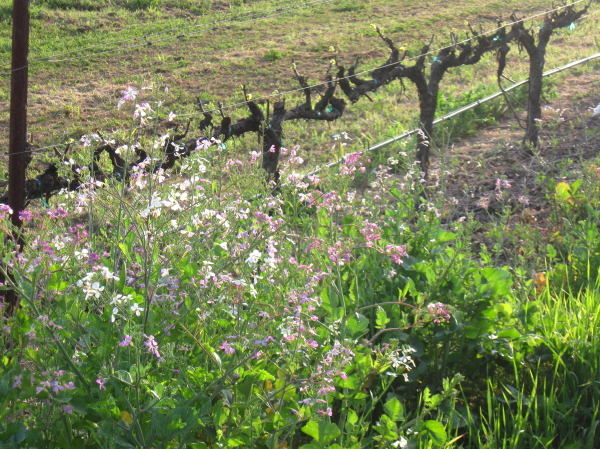
There is an excitement in the air this week in Napa Valley. Is it an exclusive, fancy event? No. Is it the presence of some major celebrity chef? No. It is the mere simple presence of… bud break! The first of many tiny green leaves have emerged on the grape vines and signal a burst of elation for wine country as spring begins. Those small green leaves represent the start of another season of wine grapes and the vintages to come. Indeed it is a sweet sense of celebration and what better way to acknowledge it than with a bottle of Bubbles.
Festive are Bubbles and no two bottles are created equally. Aside from the grapes selected, sparkling wine generally is classified by its level of sweetness. Prior to the final corking, a dosage (specifically, a shipping dosage) is added to the bottle of sparkling wine. The dosage is a sugar-wine mixture. The wine added to the dosage is typically part of the original wine used to make the sparkling wine which has been reserved. Depending on how much sugar is added to the dosage will determine the sweetness of the sparkling wine.
While all of that sounds straight-forward, how do you determine the level of sweetness in your Bubbles? It is actually blatantly displayed on the label: extra brut; brut; extra sec or extra dry; sec; demi-sec; or doux. If a sparkling wine is “extra brut” it is generally totally dry to very dry, containing less than 0.6 percent sugar. A “brut” sparkling wine (being very dry to almost dry) contains less than 1.5 percent sugar. Slightly sweeter is the “extra sec” or “extra dry” which contains 1.2 to 2 percent sugar. Described as a medium sweet sparkling wine, “sec” contains 1.7 to 3.5 percent sugar. Falling towards the end of the spectrum is “demi-sec” which is described as sweet and contains 3.3 to 5 percent sugar and “doux” (being very sweet) contains over 5 percent sugar. “Demi-sec” and “Doux” sparkling wines are generally considered dessert wines in the world of Bubbles. However, should “demi-sec” wines be limited to being served with dessert?
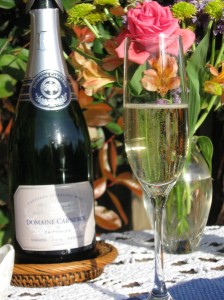
While a “demi-sec” sparkling wine pairs easily with desserts, its sugar content can be used to seamlessly pair with certain spicy fare. “Demi-sec” sparkling wines are not commonly found in Napa Valley but from time to time, Domaine Carneros makes one named “Vermeil”. The 2005 Vermeil Demi-Sec is lightly sweetened and uniquely involves two of Domaine Carneros’ wines: its traditional Brut and an overlay of its renowned Le Rêve sparkling wine. Its nose offers tantalizing aromas of apricot, honeysuckle, apples and citrus. In the mouth, the wine is fuller but it is not overwhelmingly sweet (unlike many traditional dessert wines). With slight notes of almond, vanilla and caramel, the wine has a rich smooth feel and its light sweet nature dances across the palate. Since the sugar creates a light sweetness, it is easy to envision spicy food pairings to fit alongside this wine. With this in mind, this week’s menu holds:
1) Grilled Salmon in a Mango-Ginger-Habanero Marinade;
2) Herbed Pearl Couscous With Garlic, Meyer Lemon and Peas; and
3) Baked Honeyed Berry Nectarine Puff Pastry.
While a demi-sec sparkling wine will pair well with spicy fare, to create a copasetic food pairing, it is best if a fruit sauce is involved. A mango-ginger-habanero marinade embraces the best of both worlds with the sweet nature of mango, the refreshing heat of ginger and the feisty spice of the habanero chile. Grilling the salmon on a smoky charcoal grill adds flavorful depth and the light nature of fish intuitively pairs with sparkling wine. Neither the fish nor the Vermeil demi-sec outweighs the other in flavor or texture. Instead it is almost as if each has met its soulful match.
To further add dimension and texture to the meal, the grilled salmon is placed upon a bed of herbed pearl couscous. The pearl couscous has a semi-soft texture yet is firm. Deliciously seasoned with herbs, garlic and meyer lemon, the pearl couscous is also tossed with steamed peas. When paired with the Vermeil demi-sec, the sweetness of the steamed peas mirrors the sugar in the wine and the wine’s clean lingering finish flirts with the notes of meyer lemon in the pearl couscous.
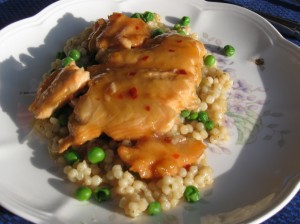
Since the featured sparkling wine is a demi-sec and traditionally a dessert wine, a menu would be remiss without the pairing of something sweet to finish the meal. While demi-sec sparkling wines pair well with recipes involving fruit, the type of fruit selected should be a careful decision. Using stone fruit is a good start and narrowing the selection to baked yellow nectarine truly captures the flavors in the Vermeil demi-sec and enhances the fruit and floral aromas of the wine. Puff pastry is dressed with raspberry honey and adorned with fresh raspberries (which are presently seasonal) and blueberries picked from the back patio. This not only creates a flavorful and mildly sweet dessert, but is a great way to start spring by utilizing fresh produce and the concept of sustainability. Controlling the sugar content of the dessert and relying instead on the natural sugar of honey and fresh fruit emulates the same degree of sweetness found in the sparkling wine.
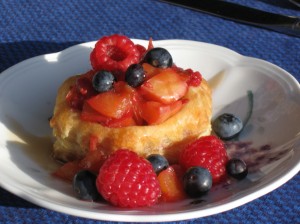
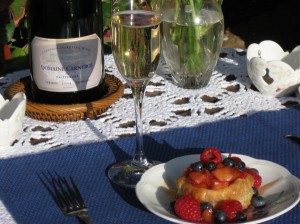
In the end, experimenting with a sweeter sparkling wine is a rewarding culinary adventure. It spices up traditional pairings and introduces the palate to a luxuriously refined, yet less dry wine. With the newfound energy of spring and the optimism of bud break in Napa Valley, the senses awaken from winter and it is the perfect time to explore all things creatively culinary.
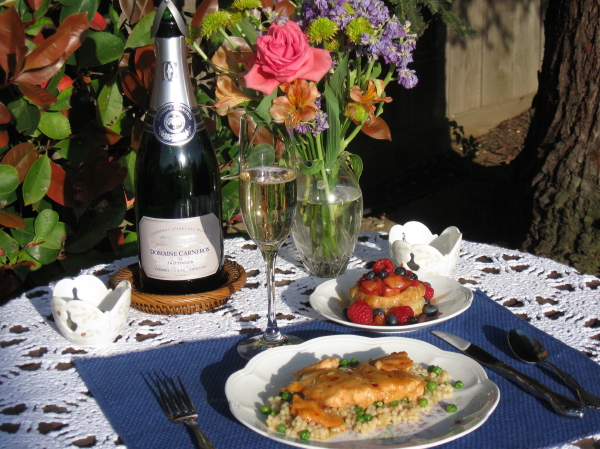
Comments Off on Break Out the Bubbles for Bud Break!